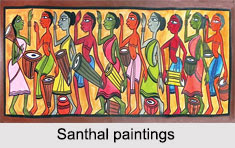जादोपटिया चित्रकला , झारखंड

झारखंड में चित्रकला खासकर लोक चित्रकला की समृद्ध परंपरा रही है, जिसमें मुख्य रुप से आदिवासी समुदायों की जीवनशैली, सामाजिक, धार्मिक व सांस्कृतिक मान्यताएं परिलक्षित होती हैं. आदिवासी पुरातन समय से ही प्रकृति के उपासक रहे हैं. उनका जीवन प्रकृति के सहज सौंदर्य से प्रेरित रहा है और यह सौंदर्य बोध उनके द्वारा उकेरी जानेवाली चित्रकलाओं में स्पष्ट दिखती हैै. ऐसी ही प्राचीन लोक चित्रकला है जादोपटिया, जिसे झारखंडी लोकशैली भी कहा जाता है. जादोपटिया मुख्यत: समाज के उद्भव, विकास, धार्मिक मान्यताओं, मिथकों, रीति–रिवाजों और नैतिकता को अभिव्यक्त करता है. यह चित्रकला संतालों की पहचान है. दरअसल, जादो संताल में चित्रकार को कहा जाता है. इन्हें पुरोहित भी कहते हैं. ये कपड़े या कागज को जोड़कर एक पट्ट बनाते हैं फिर प्राकृतिक रंगों से उसमें चित्र उकेरते हैं. जादो द्वारा कपड़े या कागज के छोटे–छोटे टुकड़ों को जोड़कर तैयार पट्टों को जोड़ने के लिए बेल की गोंद का प्रयोग किया जाता है जबकि प्राकृतिक रंगों की चमक बनाए रखने के लिए बबूल केे गोंद मिलाये जाते हैं. चित्रकारी के लिए बनाया जानेवाला यह पट्ट पांच...





